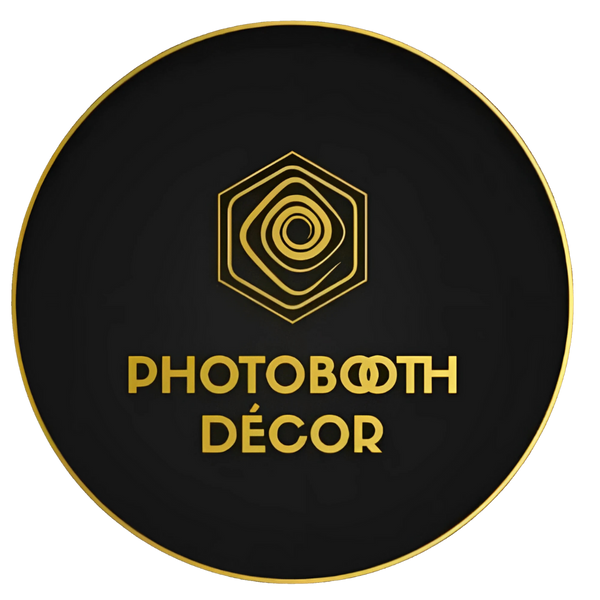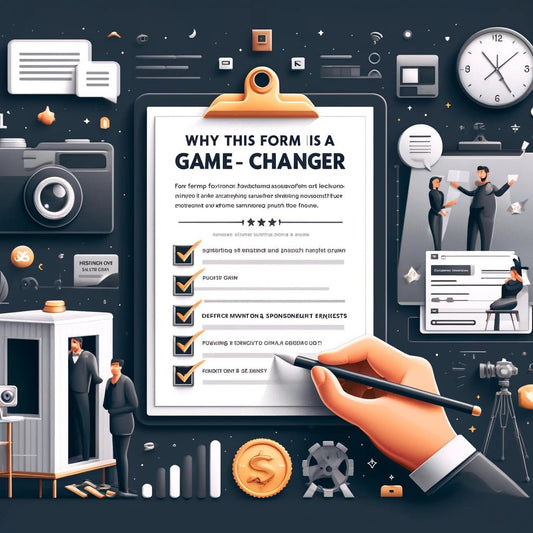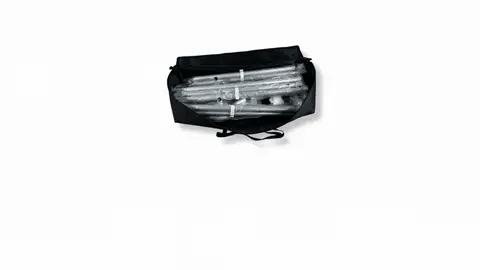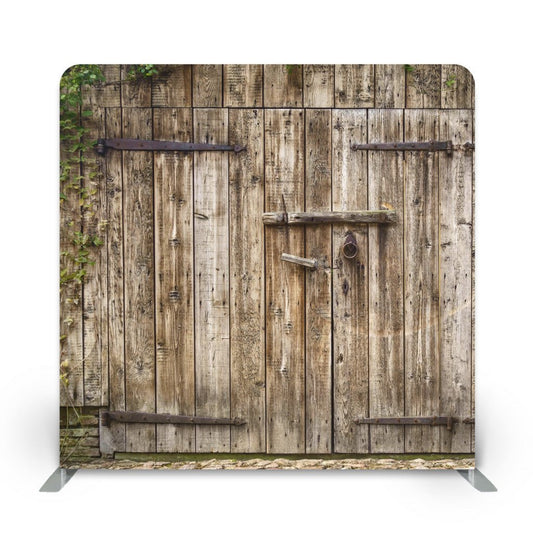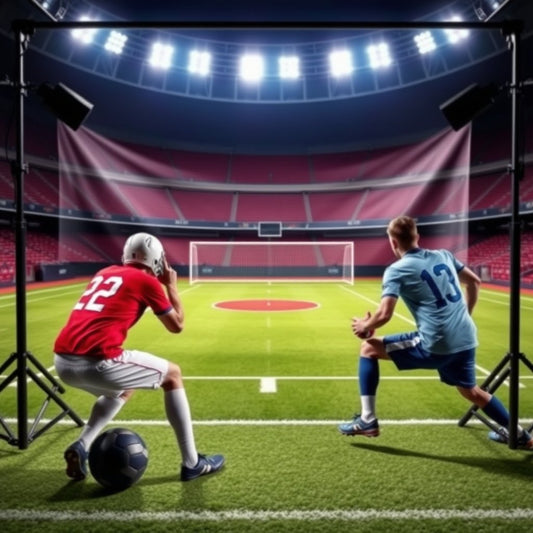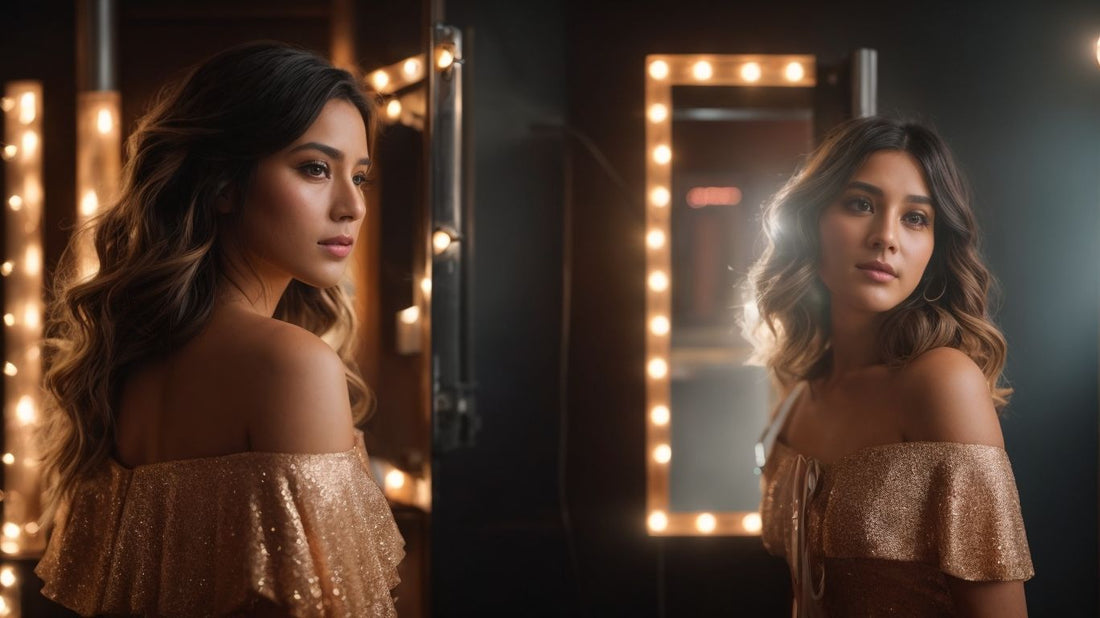
The Ultimate Guide to DIY Photo Booth Lighting: Tips and Tricks for Perfectly Lit Pictures
Share
.jpg)
DIY photo booth lighting is an essential aspect of creating a stunning and professional-looking photo booth setup. The right lighting equipment and techniques can make a significant difference in the quality of photos and the overall ambiance of the booth. The first step in achieving optimal photo booth lighting is to choose the right lighting equipment. This involves understanding different lighting options, determining your budget, and considering the size of your photo booth.
Once you have chosen your lighting equipment, you can move on to setting up the lights in your DIY photo booth. This includes assessing the venue's lighting conditions, positioning the lights strategically, and using light modifiers to control and shape the light. There are various DIY photo booth lighting techniques you can employ, such as using softbox lights, creating a ring light effect, and incorporating colored gels for added creativity.
To ensure excellent photo booth lighting, it is crucial to balance ambient and artificial light, experiment with light angles, and make use of reflectors and diffusers. By following these tips and techniques, you can create a visually appealing and well-lit photo booth for your next event.
Tips for Choosing the Right Lighting Equipment
When it comes to creating the perfect DIY photo booth, choosing the right lighting equipment is key. Let's dive into some valuable tips that will help you make the best choice. From understanding different lighting options to determining your budget and considering the size of your photo booth, this section will empower you with the knowledge you need for stunning photo booth lighting. So, let's shed some light on this illuminating topic!Understanding Different Lighting Options
Understanding different lighting options is crucial when setting up a DIY photo booth. Here are some common lighting options to consider:
| Option | Description |
| Softbox Lights | These provide soft, diffused lighting and are great for capturing flattering portraits. |
| Ring Light | A ring-shaped light that creates a halo effect, ideal for highlighting facial features. |
| Colored Gels | These filters can be placed over lights to add a creative and dynamic element to your photos. |
Understanding the different lighting options allows you to choose the best setup for your specific needs and desired ambiance. By experimenting with these options, you can create stunning and professional-looking photos in your DIY photo booth.
Determining Your Budget
Determining your budget for DIY photo booth lighting involves considering several factors to ensure you stay within your financial means. Here is a step-by-step guide to help you:
Research different lighting equipment options to get an idea of price ranges.
Set a realistic budget based on your financial capabilities and the quality of lighting you desire.
Consider any additional costs such as batteries, light modifiers, or cables.
Prioritize your lighting needs and allocate your budget accordingly.
Compare prices from different vendors or online platforms to find the best deals.
Consider renting equipment if you have a limited budget or only need lighting for a specific event.
Keep track of your spending and make adjustments as necessary to stay within your budget.
Determining Your Budget for DIY photo booth lighting is a crucial step in the process. To successfully plan your expenses, you need to consider several factors and stay within your financial means. To assist you, here is a detailed guide to help you with setting up your budget:
Begin by conducting thorough research on different lighting equipment options available. This will provide you with an understanding of the price ranges.
Based on your financial capabilities and the level of lighting quality you desire, set a realistic budget for your DIY photo booth lighting project.
Do not forget to take into account any additional costs that may arise, such as buying batteries, light modifiers, or cables.
Once you have determined your budget, it is essential to prioritize your lighting needs and allocate your funds accordingly.
To ensure you get the best deals, compare prices from various vendors or explore online platforms.
If you have a tight budget or require lighting for a specific event, consider the option of renting equipment.
Lastly, it is important to keep track of your spending and make any necessary adjustments to ensure you stay within your budget.
Considering the Size of Your Photo Booth
Considering the Size of Your Photo Booth is a crucial factor when choosing the right lighting equipment. Here are some important factors to consider:
Pro-tip: Always leave some extra space around your photo booth for any adjustments or unforeseen needs that may arise during the event.
Setting Up Your DIY Photo Booth Lighting
Setting up your DIY photo booth lighting is crucial for capturing those perfect moments. In this section, we'll delve into the key aspects of creating the ideal lighting setup. Discover how assessing the venue's lighting conditions, strategically positioning the lights, and utilizing light modifiers play essential roles in achieving stunning photo booth results. Get ready to transform your ordinary snapshots into extraordinary memories with expert lighting techniques.Assessing the Venue's Lighting Conditions
Assessing the venue's lighting conditions is crucial for setting up an effective DIY photo booth lighting. Here are the steps to follow:
- Beforehand, make sure to assess the lighting conditions at the venue.
- Pay attention to the type of lighting available, whether it be natural light from windows or artificial light from overhead fixtures.
- Take into account the intensity and color temperature of the existing lighting, as it can greatly impact the overall appearance of the photos.
- Identify any areas within the venue that may have insufficient lighting or shadows that require attention.
- Determine if additional lighting equipment, such as softbox lights or LED panels, is necessary to enhance the lighting conditions.
- Capture test shots in various areas of the venue to evaluate the effect of the lighting on the photos.
- Make any necessary adjustments, such as repositioning lights or using light modifiers, to achieve the desired lighting conditions.
Positioning the Lights
Positioning the lights is essential when it comes to achieving excellent photo booth lighting. Here are some helpful tips to consider:
Assess the Venue's Lighting Conditions: Before positioning the lights, it is crucial to evaluate the existing lighting in the venue. This assessment will help determine the areas that require additional illumination.
Placement: To eliminate shadows and create even lighting across the photo booth, strategically position the lights. Don't hesitate to experiment with different angles to achieve the desired effect.
Utilize Light Modifiers: Enhancing the direction and intensity of the light can be done with the use of light modifiers such as umbrellas, softboxes, or reflectors. Incorporate these modifiers to improve your lighting setup.
By carefully following these tips, you can ensure that your DIY photo booth lighting is efficient and enhances the overall quality of the photos.
Using Light Modifiers
Using light modifiers can significantly enhance the quality of your DIY photo booth lighting. Here are some steps to effectively use light modifiers:
- Choose the right modifier: Determine the effect you want to achieve and select the appropriate light modifier, such as umbrellas, softboxes, or reflectors.
- Position the light modifier: Place the light modifier in a way that diffuses or reflects the light to create a softer and more flattering illumination.
- Experiment with distance and angle: Adjust the distance and angle of the light source to control the intensity and direction of the light.
- Combine different light modifiers: Get creative by using multiple light modifiers together to achieve unique and desired lighting effects.
- Test and adjust: Continuously assess and make necessary adjustments to achieve the best lighting results for your photo booth.
By using light modifiers effectively, you can create professional-looking photos that will impress your guests. Experiment with different light modifiers and techniques to find the perfect lighting setup for your DIY photo booth. Happy photographing!
DIY Photo Booth Lighting Techniques
Looking to take your DIY photo booth game to the next level? Get ready to dazzle your subjects with some incredible lighting techniques! In this section, we'll explore the magic of DIY photo booth lighting. From using softbox lights to create that perfect studio-like glow, to capturing a captivating ring light effect, and even incorporating colored gels for added creativity, we've got you covered. Get ready to transform your photo booth setup into a visual masterpiece that your guests won't forget!Using Softbox Lights
Using softbox lights for your DIY photo booth can greatly enhance the quality of your photos. Here is a step-by-step guide on how to effectively use softbox lights:
- Set up the softbox lights: Assemble the softbox and attach it to a light stand. Position the lights at a 45-degree angle from your subject.
- Adjust the power settings: Use softbox lights to set the intensity and achieve the desired level of illumination. Experiment with different settings to find the perfect balance.
- Position the lights: Place the softbox lights on either side of the photo booth, slightly behind the camera. This positioning will create a flattering and even lighting effect on the subject.
- Diffuse the light: Enhance the effects of softbox lights by attaching the diffuser panel to the front. This will soften the harshness of the light, reducing any unwanted shadows and creating a more pleasing appearance.
- Test and adjust: Take a few test shots to ensure that the softbox lights evenly and properly illuminate your subject. Make any necessary adjustments to the positioning or intensity of the lights.
By following these steps, you can effectively use softbox lights to achieve professional-looking lighting in your DIY photo booth.
Fun Fact: Softbox lights were first introduced in the 1980s by photographer Dean Collins, who sought a versatile lighting solution for portrait photography. Softbox lights quickly gained popularity among photographers for their ability to produce soft, diffused light, leading to beautifully lit images. Today, they are widely used in various fields of photography, including photo booths.
Creating a Ring Light Effect
Creating a ring light effect for your DIY photo booth lighting can enhance the quality of your photos and give them a professional touch. If you want to achieve this effect, follow these simple steps:
- Obtain a ring light: To get started, purchase or create a ring light that is compatible with your camera lens.
- Position the light: Once you have the ring light, mount it directly in front of your camera lens. This will ensure that the light evenly illuminates the face of your subject.
- Adjust the intensity: Experiment with the brightness settings of the ring light to achieve the desired effect. By using a softer light, you can create a diffused and flattering look.
- Play with color temperature: Some ring lights offer different lighting options, allowing you to switch between warm and cool tones. Choose the one that best suits the theme or mood of your photo booth.
Incorporating Colored Gels
Using colored gels in your DIY photo booth lighting setup can add a creative touch and enhance the atmosphere of your photos. Incorporating colored gels can be achieved in several ways:
- Choose the right gels: Select gels that complement the theme or mood you want to create. Experiment with different colors like blue, red, or yellow.
- Placement: Attach the gels to your light sources, such as strobes or LED lights, to modify their color. Place the gels in front of the light to achieve the desired effect.
- Play with intensity: Adjust the distance between the gels and the light to control the intensity of the color. Moving the gel closer to the light will result in a more vibrant hue, while moving it farther away will create a softer color.
- Mix and match: Combine different colored gels to create unique color combinations and effects. For example, layering blue and red gels can create a purple glow.
- Experiment: Don't be afraid to try different combinations and techniques to achieve the desired look. Have fun and let your creativity shine!
Additional Tips for Excellent Photo Booth Lighting
Looking to take your DIY photo booth lighting to the next level? Look no further! In this section, we'll uncover some additional tips that will elevate your photo booth lighting game. From finding the perfect balance between ambient and artificial light to experimenting with unique light angles, we've got you covered. Plus, we'll show you how to make the most of reflectors and diffusers to achieve stunning results. Get ready to capture unforgettable moments with these expert lighting techniques!Balancing Ambient and Artificial Light
When setting up your DIY photo booth lighting, achieving the optimal results depends on balancing ambient and artificial light. To help you achieve this balance, here are some tips:
1. Begin by assessing the lighting conditions of the venue. Take note of the existing ambient light sources, like windows or overhead lights.
2. Strategically position your artificial lights to complement the ambient light. If the venue is well-lit, use the artificial lights as fill lights to soften shadows. In contrast, if the venue is dimly lit, the artificial lights should serve as the primary source of illumination.
3. Experiment with different light angles to achieve the desired effect. You can angle the lights towards the subject to create dramatic shadows. Alternatively, diffusing the light can produce a softer and more flattering look.
4. Enhance the light manipulation by using reflectors and diffusers. Reflectors bounce light back onto the subject, while diffusers soften harsh light.
By finding the right balance between ambient and artificial light, you can capture stunning photos in your DIY photo booth.
Experimenting with Light Angles
When setting up your DIY photo booth lighting, experimenting with light angles can have a significant impact on the quality and mood of your photos. Here are some steps to consider:
- Start by experimenting with light angles: Begin by positioning your lights at various angles, illuminating your subject without any specific artistic intent.
- Try different heights: Experiment with raising or lowering your lights to create different shadows and highlights. Higher angles can create a more dramatic look, while lower angles can soften features.
- Use different positions: Move your lights around your subject to explore different effects. Side lighting can create depth and add dimension, while front lighting can produce a more even and flattering illumination.
- Play with backlighting: Experiment with positioning a light behind your subject to create a halo effect or silhouettes, adding a sense of drama and intrigue to your photos.
- Consider reflections: Utilize reflective surfaces or add mirrors to bounce light and create interesting reflections or unique lighting patterns.
By experimenting with different light angles, you can add creativity and artistic flair to your DIY photo booth setup, resulting in stunning and captivating images.
Utilizing Reflectors and Diffusers
Utilizing reflectors and diffusers is crucial for achieving excellent photo booth lighting. To make the most of these tools, follow these steps:
- Strategically position the reflector to bounce light onto the subject's face, reducing harsh shadows. Experiment with different angles to find the most flattering effect.
- Choose a white, silver, or gold reflector based on the desired outcome. A white reflector creates a soft and natural fill light, while a silver reflector provides a cooler and more specular light. If you prefer warmth and richness, go for a gold reflector.
- To soften and spread the light, place the diffuser between the light source and the subject. This helps minimize glare, reduce contrast, and create a more flattering light.
- Opt for a diffuser material like translucent fabric or a dedicated diffuser panel. Position it close to the light source for the best diffusion effect.
- To have more control over the light and achieve the desired look, consider using multiple reflectors and diffusers.
- Continuously assess and adjust the positioning of reflectors and diffusers throughout the photo session to ensure optimal lighting.
By following these steps and making use of reflectors and diffusers, you can enhance the overall lighting quality of your DIY photo booth setup.
Some Facts About DIY Photo Booth Lighting:
- ✅ Using clip lamps or stand-up lamps with DIY diffusers can be a cost-effective way to improve the lighting in a DIY photo booth setup. (Source: Our Team)
- ✅ A cheap two-light continuous CFL lighting kit with umbrellas or softboxes can also provide better quality lighting for photo booths while being portable and affordable. (Source: Our Team)
- ✅ Off-camera flashes or a single flash with an umbrella can be used to enhance the lighting in a DIY photo booth setup. (Source: Our Team)
- ✅ The Neewer CN-160 or similar lighting solution is a recommended option for improving photo booth lighting without breaking the budget. (Source: Our Team)
- ✅ Strobes are considered ideal for photo booth lighting, but they may be out of budget for DIY setups. (Source: Our Team)
Frequently Asked Questions
1. What are some budget-friendly lighting options for DIY photo booths?
Some budget-friendly lighting options for DIY photo booths include clip lamps or stand-up lamps with DIY diffusers, a cheap two-light continuous CFL lighting kit with umbrellas or softboxes, off-camera flashes or a single flash with an umbrella, and a Neewer CN-160 or similar lighting solution. Strobes are ideal but may be out of the budget.
2. Can I use stand-up lamps for lighting in a DIY photo booth?
Yes, stand-up lamps can be a suitable lighting option for DIY photo booths. You can use clip lamps or stand-up lamps with DIY diffusers to provide directional lights and improve the quality of your photos.
3. How can I capture better photos without using the on-camera flash in my DIY photo booth?
To capture better photos without using the on-camera flash, you can consider using off-camera flashes or a single flash with an umbrella. These lighting solutions help avoid unflattering results and provide more professional lighting for your DIY photo booth.
4. Is it possible to achieve good lighting in a well-lit room for a DIY photo booth?
Yes, it is possible to achieve good lighting in a well-lit room for a DIY photo booth. You can utilize the existing light in the room and supplement it with additional lighting equipment such as off-camera flashes or stand-up lamps to enhance the overall lighting quality.
5. What are some options for sharing photos taken in a DIY photo booth digitally?
There are several options for sharing photos taken in a DIY photo booth digitally. You can use a photo booth app, such as Tap Booth or other similar apps, to send photos directly to guests via text, email, or social media platforms. This allows guests to easily access and download their photos digitally.
6. Are there any recommended lighting kits specifically designed for DIY photo booths?
Yes, there are lighting kits available specifically designed for DIY photo booths. One popular option is the Spectrum Aurora Gold Luxe II YouTube Video Lighting Kit, which provides professional lighting for photo booths. Additionally, the Spectrum Aurora Max Ring Light and Crystal Luxe Sidelight Panels offer versatile shooting areas and maximum stability for your DIY photo booth setup.
